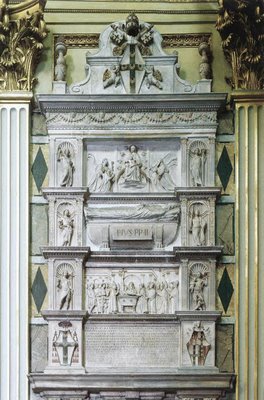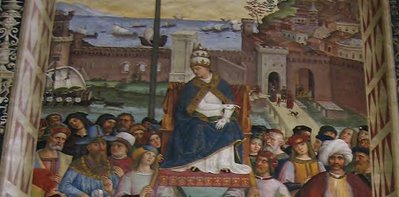
PAOLO ROMANO (c. 1415-1473)
Tomb of Pius II 1465-70 Marble
Sant'Andrea della Valle, Rome
The tomb of Pius II was made under the artistic direction of Paolo Romano. The design of the tomb, a wall monument with three orders of architraves and three niches with shell vaults on each side is attributed to Paolo Romano, who executed for it an unfinished recumbent figure of the pope as well as the upper relief with Sts Peter and Paul, who are shown presenting the donors, Pius II and Cardinal Francesco Todeschini, to the Virgin.
The central relief, on the other hand, depicting the presentation of the relic of St Andrew's head, and the virtues standing in the flanking niches, is attributed to the Master of Pius II, whose style shows the influence of Paolo Romano and Mino da Fiesole.
In 1614 the tomb was transferred from St Peter's to its present location, the church of Sant'Andrea della Valle.
The negotiations for the acquisition by Pius II of the reputed head of the Apostle Andrew were carried out on his behalf by Cardinal Bessarion.
The skull was brought to Italy by Thomas Palaeologus (the despot of Morea and brother to the last Christian emperor of Constantinople), who, in return, was given the Golden Rose, a palace in Rome and an annual allowance of 6,000 ducats. Pius II promised to keep the skull and Thomas safely "as long as danger threatened".
The relic was received with ostentatious signs of devotion.
Bessarion and two other members of the sacred college received it at Narni and conveyed it to Rome.
The pope, accompanied by the remaining cardinals and the Roman clergy, went out to the Ponte Molle to give it welcome.
After falling prostrate before the Apostle's skull, Pius delivered an appropriate address in which he congratulated the dumb fragment upon coming safely out of the hands of the Turks to find at last, as a fugitive, a place beside the remains of its brother Apostles. The address being concluded, the procession reformed and, with Pius borne in the Golden Chair, conducted the skull to its last resting-place.
The streets were decked in holiday attire, and no one showed greater zeal in draping his palace than Rodrigo Borgia.
The skull was deposited in St. Peter's, after, as Platina says, "the sepulchres of some of the popes and cardinals, which took up too much room, had been removed."
The ceremonies were closed by Bessarion in an address in which he expressed the conviction that St. Andrew would join with the other Apostles as a protector of Rome and in inducing the princes to combine for the expulsion of the Turks.
In 1462 Pius erected a monument on the site of the Milvian Bridge where the initial ceremonies had taken place: the Tempietto di Sant'Andrea a Ponte Milvio.
Thomas Palaiologos (Θωμάς Παλαιολόγος) (1409– May 12, 1465) was the youngest surviving son of the Eastern Roman Emperor Manuel II Palaiologos and his wife Helena Dragaš. After the desertion of his older brother to the Turks in 1460, Thomas Palaiologos became the legitimist claimant to the Byzantine throne.
After the Fall of Constaninople, Thomas sought western support against both the Ottomans and his competitive pro-Ottoman brother Demetrios. He allied with Genoa and the Pope, and defeated Demetrios, who fled seeking help from the Ottomans in 1460. The Ottoman army duly attacked Morea and quickly breached the Hexamilion wall across the Isthmus of Corinth, which was too long to be effectively manned and defended by Thomas' forces. Thomas escaped with his family to Italy, where he had already been recognized as the legitimate heir to the Byzantine Empire at Rome.
The commanders of the garrisons of the fortified cities in Morea, deserted by their rulers, chose individually whether to fight or surrender, depending on their own will and circumstances. In the final battle of the Roman Empire in its Byzantine incarnation, Graitzas Palaiologos, the military commander of the city of Salmenikos defeated Mehmed II, who after a month of siege returned home without conquering that "unimportant city".
In the following year Graitzas received an offer to become general of the Republic of Venice, which he accepted, thus leaving Salmenikos to the Ottomans.
After the fall of Morea, Thomas lived in Rome, recognized throughout Christian Europe as the rightful Emperor of the East. To create greater support for his situation Thomas changed his religion to Catholicism in his last years of life.
We can glean something of the appearance of Thomas Palaiologus from a marble statue of him, commissioned by Pius II. The statue was executed by the Pope’s principal sculptor, Paolo Tacconi di Sezze, also known as Paolo di Mariano, but better known as Paolo Romano. The sculptor, active in Rome in the fifteenth century, hid the identity of his Greek guest under the features of Saint Paul.
The true identity of the statue is revealed by Feliciano Bussi in his Cronaca Viterbese, in which he refers to the despot of Morea: “He died in Rome and since he was a handsome man, Pope Pius commissioned a marble sculpture of him and had it placed by the steps of Saint Peter’s…” (“Morìo in Roma et papa Pio lo fe fare di marmo, cioè quello sancto Paulo a le scale disancto Pietro in sua figura, che fu bellissimo omo…”). The statue is now in a room of the Library of Sixtus IV, in the Apostolic Palaces.
The story would appear to be confirmedby Kenneth Setton in the second volume of his Papacy and the Levant, where, in a rather elusive footnote, he writes: “Thomas Palaiologus […] seems to have left behind him a curious memorial which still exists in fine conditions at the Vatican”. The statue of Thomas Palaiologus in the guise of Saint Paul can still be seen to this day, although actually not within the Vatican, but on the right hand side of the entrance to Ponte Sant’Angelo, located there by Clement VII after the Lanzichenecchi sack.
The refined, almost sorrowful beauty of Thomas Palaiologus appears to have enchanted his western hosts during his stay in Italy. “Bellissimo omo”, remarks Feliciano Bussi in his chronicle. The ambassadors of Francesco Sforza were equally impressed: “As dignified as any man upon the earth could be,” they exclaimed when they met him in Venice on 25 June, 1462, “reasonably tall in stature and his face carries such a wonderfully grave and prudent expression, which isconfirmed by the very way in which he speaks”.
Bartolomeo Bonatto, confidant of Barbara Gonzaga and representative of the Marquises of Mantua was as equally gushing: ”He certainly is a handsome man and he possesses a beautifully dignified expression, he has good manners and is very refined” (“Di presentia al mondo non poria esser più degno, di statura grande assay, et simostra si maravigliosa gravita et prudencia in laspecto suo, il che se conferma oltra modo nelparlare suo”).
On 2 January, 1463, in another letter to Barbara Gonzaga, Bartolomeo Marascawrote that he had met the last sovereign of the Morea at a dinner party given by her son, the Cardinal Francesco Gonzaga: “He is an impressive gentleman; he ate little during dinner and is sorely grieved” (Certo è un bel homo e ha uno bello et grave aspecto et bon modi et moltosignorili”).
Pictures of Thomas crop up in a number of other “concealed portraits”, hidden in the last artistic commissions of Enea Silvio Piccolomini and those of his descendants.
In several paintings commissioned more than a century later by Francesco Maria Piccolomini, the descendant of Pope Pius II, from the Flemish artist Bernard Rantwyck and now housed in the Museum of Pienza. Each of the five paintings commemorate the various stages of the translation of the head of Saint Andrew. In the first painting, Thomas is depicted in the port of Patras. Havingalready retrieved the priceless relic, he takes it back to the ship on a white silk shawl.
In the Piccolomini Library in the Duomo in Siena, the last of the frescoes in the cycle depicts Pius II as a dying man in the port of Ancona. Sat, pale and exhausted in a sedan chair, the eyelids drooping below his white eyebrows, next to him there is a blonde bearded aristocrat, dressed in blue with blue wide opened eyes . This again is Thomas Palaiologos.

In ORTHODOXY ON SALE: THE LAST BYZANTINE, AND THE LOST CRUSADE by Silvia Ronchey, University of Siena, Italy at http://www.byzantinecongress.org.uk/plenary/VI/VI_Ronchey.pdf., Ronchey provides evidence to support a theory that Pius and the Greek leaning cardinals had decided that after a successful Crusade against the Turks, Thomas Palaiologos was to be placed as the legitimate ruler of the re-conquered New Byzantium which was to be under the control of the West.
After his death in 1465 position of rightful Byzantine emperor fell to his older son Andrew (Andreas) Palaiologos, born in Mistra around 1455.
Mehmed II conquered the Empire of Trebizond, de facto the last free territory of the ancient Roman state, in the year 1461. Nevertheless, Mehmed had already proclaimed himself "Roman Emperor" upon capturing Constantinople in 1453.
Playing a great political game, Pope Paul II arranged in 1472 a marriage between the Catholic daughter of Thomas, Zoe Palaiologina (renamed Sophia), and Grand Prince Ivan III of Russia, with the hope of making Russia a Catholic country. This attempt to unite churches failed.
Nonetheless, because of this marriage, Moscow began in the following century its imperial policy of "third Rome". Moreover, Thomas' great-grandson was Ivan IV of Russia, the first emperor (tsar) of Russia to be crowned as such (the imperial title had already come into use under Ivan III and his son Vasili III of Russia). The last known descendant of Zoe/Sophia was Maria of Staritsa, wife of Livonia's king Magnus . She died in 1610.

interesting stuff. As the whole life and matters of Enea Silvio Piccolomini/Pius II and his cardinal Bessarion.
ReplyDeleteSee also the book of Silvia Ronchey: L'Enigma di Piero
and my website on Enea Silvio Piccolomini:
http://home.planet.nl/~golds067/intro.htm
Many thanks, Michael, for your kind comments.
ReplyDeleteAll students of Pius II are indebted to you for your work on the subject and in particular your website where you have made the result of your researches available to the general public.